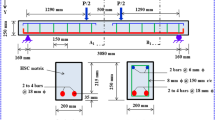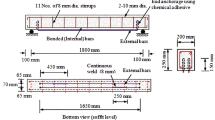Experimental testing and non-linear finite element analysis using discrete reinforcement modeling of six numbers of reinforced concrete beams under four-point bending are presented in this paper. Finite element modeling of reinforced concrete beams is carried out using ANSYS 12.0, and the critical values of the results are also compared with analytical values calculated using IS 456: 2000 codal provisions. Wide-range graphical display of the results such as deflected shape of the beam, stress-strain variation along the length and depth of the beam and crack propagation is generated by creating a batch file using the ANSYS parametric design language. Comparison is made between the test results, finite element analysis and analytical values with respect to initial crack formation and the ultimate capacity of beams, in order to have a wide understanding on the behavior, which may reduce the physical destructive laboratory testing for the future researchers.













Similar content being viewed by others
References
IS 456: 2000. Indian Standard: Plain and Reinforced Concrete – Code of Practice, Bureau of Indian Standards, New Delhi (2000).
E. R. Buckhouse, External Flexural Reinforcement of Existing Reinforced Concrete Beams Using Bolted Steel Channels, Master of Science Thesis, Marquette University, Wisconsin (1997).
A. J. Wolanski, Flexural Behavior of Reinforced and Prestressed Concrete Beams Using Finite Element Analysis, Master of Science Thesis, Marquette University, Wisconsin (2004).
D. Kachlakev, T. Miller, S. Yim, et al., Finite Element Modeling of Reinforced Concrete Structures Strengthened with FRP Laminates, Final Report SPR 316, Oregon Department of Transportation (2001).
P. Fanning, “Nonlinear models of reinforced and post-tensioned concrete beams,” Electr. J. Struct. Eng., 2, 111–119 (2001).
L. Dahmani, A. Khennane, and S. Kaci, “Crack identification in reinforced concrete beams using ANSYS software,” Strength Mater., 42, No. 2, 232–240 (2010).
F. A. Tavarez, Simulation of Behaviour of Composite Grid Reinforced Concrete Beams Using Explicit Finite Element Methods, Master of Science Thesis, University of Wisconsin–Madison, Madison, Wisconsin (2001).
G. Vasudevan and S. Kothandaraman, “Modeling and simulation of RC beams using ANSYS by APDL batch mode approach,” CiiT Int. J. Data Min. Knowledge Eng., 3, No. 11 (2011).
G. Vasudevan and S. Kothandaraman, “Behaviour prediction of RC beams- comparison of experimental, FEA and analytical methods,” in: Proc. of the IEEE Int. Conf. on Advances in Engineering, Science, and Management (Nagapattinam, India, 2012), pp. 365–370.
ANSYS Commands Reference, ANSYS, http://www.ansys.com (2005).
Author information
Authors and Affiliations
Additional information
Translated from Problemy Prochnosti, No. 2, pp. 149 – 162, March – April, 2013.
Rights and permissions
About this article
Cite this article
Vasudevan, G., Kothandaraman, S. & Azhagarsamy, S. Study on Non-Linear Flexural Behavior of Reinforced Concrete Beams Using ANSYS by Discrete Reinforcement Modeling. Strength Mater 45, 231–241 (2013). https://doi.org/10.1007/s11223-013-9452-3
Received:
Published:
Issue Date:
DOI: https://doi.org/10.1007/s11223-013-9452-3




